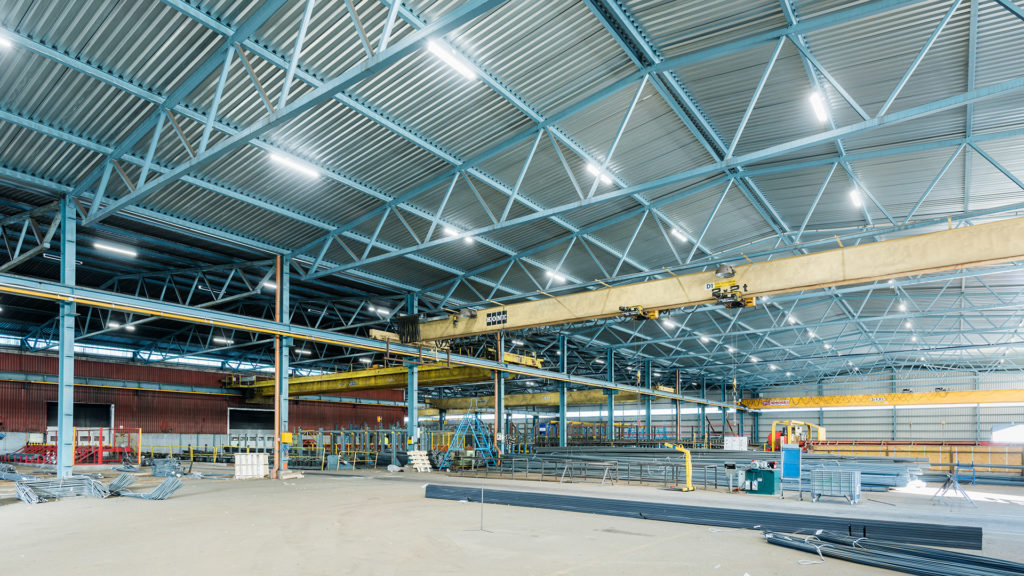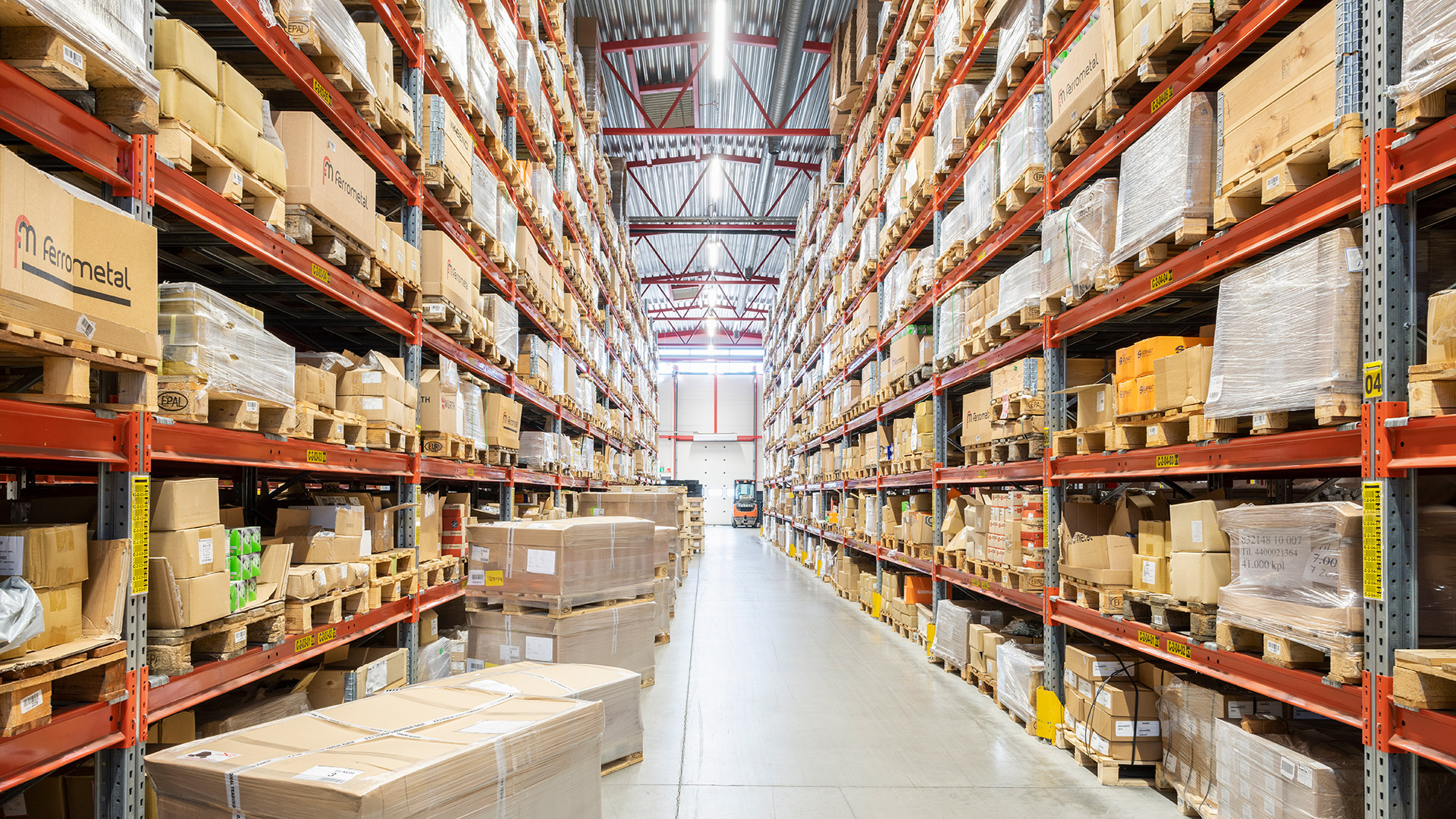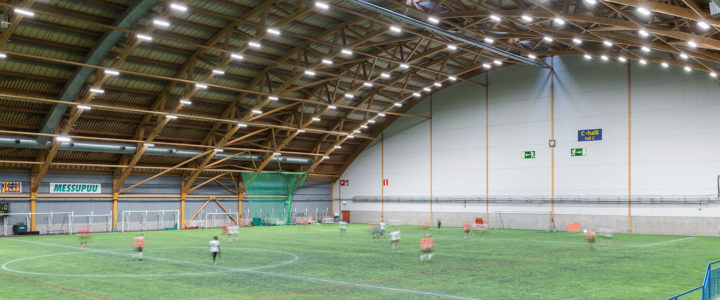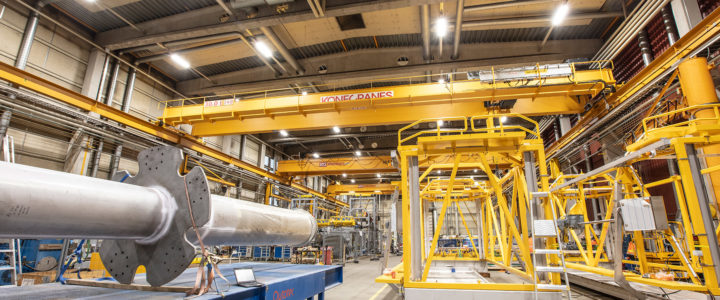Talk to our lighting experts  +358 20 125 5800
+358 20 125 5800

June 23, 2021
The Designer’s View on Great Hall Lighting
How to produce a functional and practical hall lighting solution? For this article, we interviewed lighting specialists at Greenled who have designed the lighting of hundreds of industrial, logistics and sports halls.
Where to start? Focusing on customer needs
Successful hall lighting always starts with the customer’s needs and hopes. What type of space is in question, what kind of activity/work is carried out on the premises, what are the main goals for the lighting retrofit? The lighting standards act as a basis for the design, but a good designer also knows how to challenge the customer. The uniformity of the lighting is a great example, as the minimum value provided in the standard does not usually correspond with the desired end result.
“We aim to always design the lighting with better uniformity than the minimum value provided in the standard. For customers, uniformity levels 0.5 and 0.7 may not mean much, but the eye can definitely spot the difference. In logistics, for example, this directly correlates with comfort, safety and flawlessness.”
Kalle Lumila, Lighting Specialist, Greenled
The premises are assessed before the lighting design begins. The assessment includes examining the fastening methods of the current luminaires, the placement of railings, the number of luminaires and the reflection coefficient of the surfaces. A digital light meter is always used in the assessment to measure the current lighting levels of the premises.
When selecting high-bay luminaires, the lumen output of the luminaire plays a particularly important role. However, the designer must always look at the bigger picture where the optics of the luminaire are also significant. Dialux software is used to create a visual and illustrative layout of the future lighting system for the customer. The lighting plan is an important document for the customer as it also includes a promise of future lighting levels, realised glare values and the uniformity of lighting.
Examples of lighting retrofit goals:
- Improving safety in the working environment and minimising the number of accidents
- Improving comfort at work and the general appearance of the premises
- Saving energy and protecting the environment
- Supporting the circadian rhythm of employees through lighting
- Improving player and audience experience
Lighting for logistics and production halls
In industry, the choice of luminaires mostly depends on the type of industry. Generally speaking, the luminaire must have an adequate ingress protection rating due to the challenging conditions of various industries. The optics of the luminaire, in turn, often depend on the height and use of the space. In logistics, for example, the narrow aisles require the right type of optics.

Image: For the lighting systems of logistics halls, select optics that suit the narrow, tall aisles to evenly illuminate vertical surfaces from floor to ceiling. Pictured: Ferrometal logistics facilities after the lighting retrofit.
Viability for the environment and the work tasks is the key factor in a successful lighting system for an industrial or logistics hall. An intelligent control system to adjust the intensity of the lighting according to different work tasks and spaces creates added value. This achieves individual lighting conditions for high-precision workstations, for example, to better support the work.
Elements of great logistics lighting:
- Sufficient light. In high-bay facilities, the lumen output of the luminaires must be able to produce sufficient light from the topmost shelves all the way to the floor. The optics selected for the tall and narrow aisles should efficiently illuminate vertical surfaces.
- Light uniformity. In addition to high illuminance levels, lighting uniformity is important for both occupational safety and precision. Minimum values have been set in lighting standards, but in practice, we always aim to exceed those values.
- Glare-free light. Great logistics lighting is glare-free even if you look directly at the ceiling. Glaring light sources can even lead to occupational accidents, and in any case, they have a negative effect on comfort. Glare prevention is a particular area of focus in the design of logistics luminaires.
Logistics lighting also typically uses smart lighting control as this creates considerable energy savings and makes the facilities easier and more comfortable to use. Aisle-specific detectors allow brightening and dimming of lighting according to the use of the space. The lighting in the aisles is never completely switched off during working hours; a lower light setting is kept on to ensure safety in the facility. When a user reaches the space, the lighting is automatically brightened to offer the user the best possible light for their tasks.
What to pay attention to when illuminating industrial and production halls:
- Quality of light. In addition to the amount of light, the quality also plays a key role in an industrial environment. A colour temperature close to natural daylight and a good colour rendering index (RA≥ 80) improve visual perception and ensure that any safety colours, for example, stand out both on-site and on control room screens. In certain industries, such as printing houses or the food industry, the quality of light also plays a vital role in quality control.
- The durability of the luminaires. The luminaires must have a sufficient ingress protection rating (IP Code) as an industrial environment means that they have to withstand factors such as humidity, dust, heat, chemicals or physical impact. When selecting luminaires, it is also important to consider the cleaning methods as luminaires can be cleaned with alkaline detergents or a pressure washer, for example, depending on the environment.
When renewing the lighting system of an industrial and logistics hall, the total number of luminaires can often be reduced while increasing the amount of light in the facility. This is achieved by using long luminaires with efficient lumen output and viable optics. Fewer luminaires mean less installation work and the most cost-effective solution for the customer.
Lighting system for an ice rink and sports hall
Different sports have their own standards for both the intensity and uniformity of lighting. Typically, sports require a well-lit environment while keeping the glare at a minimum to promote great performance and the safety of the players. The viability of lighting for television broadcasts should also be considered. In this regard, it is important to ensure great colour rendering and flicker-free luminaires and focus on the optics so that vertical surfaces are lit as efficiently as possible.
The adjustability of the lighting is also important. In sports events, the lighting is often adjusted according to situations and breaks in the game, and the halls may often be used for entirely different purposes, depending on the time of year. The most convenient solution is to integrate the lighting with a smart lighting control system that helps adjust individual luminaires or luminaire groups directly through a visual 3D interface.
“The lighting standards vary between different sports, and different leagues also use their own standards. If the hall is to be used for various purposes, making the lighting adjustable is particularly important.”
Olli Hökkä, Lighting Specialist, Greenled

Image: The halls at the Tampere Exhibition and Sports Centre can be adjusted for various types of use. During a fair, the control system is used to reduce the lighting levels of the hall to bring out the lighting design of the stands.
What to pay attention to when illuminating ice rinks and sports halls:
- The durability of the luminaires. The temperature and humidity of ice rinks place high requirements for the ingress protection rating (IP Code) of the luminaires.
- Adjustability. An adjustable lighting control system makes it easier to adapt multi-function facilities for different events and sports.
- Glare control. Glare-free lighting is essential in sports halls in terms of comfort, performance and safety.
- Viability for television broadcasts. The colour rendering index (CRI) of the lighting and the efficient lighting of vertical surfaces with suitable optics are taken care of. The lighting should also be flicker-free.
In addition to the factors mentioned above, the perspective of installation is always considered when designing hall lighting. The ceiling structures are reviewed in the assessment, and the installation method is selected so that it ensures an easy and quick setup of the luminaires.
Are you interested in renewing your hall lighting?
If you were left wondering, watch this video to hear practical experiences in renewing hall lighting. Our experts will be happy to answer any questions.





